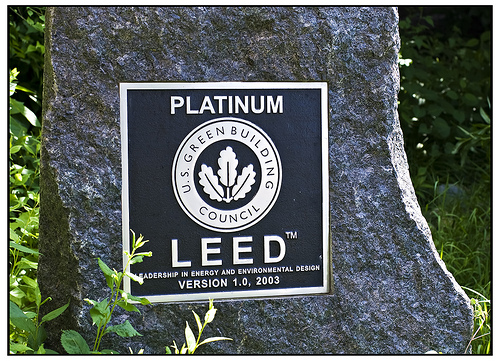 The blogs have been crackling for several weeks with reports and analysis of the LEED “challenge” process. Chris Cheatham devoted a multiple part series to analyzing the challenge filed and ultimately rejected to the LEED Gold certification awarded to the Northland Pines High School in Wisconsin. Shari Shapiro has discussed the same and included an interesting interview with the challengers discussing their reasoning for the protest.
The blogs have been crackling for several weeks with reports and analysis of the LEED “challenge” process. Chris Cheatham devoted a multiple part series to analyzing the challenge filed and ultimately rejected to the LEED Gold certification awarded to the Northland Pines High School in Wisconsin. Shari Shapiro has discussed the same and included an interesting interview with the challengers discussing their reasoning for the protest.
Without getting too bogged down in the technical details of the Northland Pines case that are covered elsewhere, I would highlight a couple important takeaways from what we have learned from the Northland Pines challenge case:
- Currently, anyone can file a challenge – there are no standing requirements whatsoever. If anyone can file a challenge, the threat to projects, and to LEED, is that anyone will file a challenge.
- There are very loose/limited guidelines or rules on procedure, hearings, document and information exchange and the like in the challenge process. Look for a future revamping adding more clarity in the challenge process rules.
- It appears that USGBC permitted Northland Pines to correct, amplify and update its submittals during the challenge process to demonstrate compliance with the prerequisites. USGBC needs to make clear whether certification requires bright line compliance based on initial submittals and information, or whether they are more interested in allowing some wiggle room as long as the project meets the standards at the end of the finish line. Failing to make this basic philosophical tenet clear is not fair to project participants, opens the process to future inconsistency during later challenges, and ultimately threatens the credibility (and thus potentially the viability) of the USGBC process.
- Last point, which may be the biggest and has not really percolated as a point of focus: as currently conceived, the LEED challenge process adds another completely unpredictable line item expense to the process. The challenge process may also add another angle of attack on projects for unhappy losers in bidding, neighborhood NIMBY uprisings, and competitors that may want at low cost and effort to financially damage their opponents. At least courts have a theoretical sanctions approach to address complaints filed in bad faith. USGBC should strongly consider adopting rules that require a USGBC member to certify the challenge as being in good faith, along with membership penalties or sanctions for individuals signing off on complaints that have zero merit.
The challenge process in theory may add an important element of credibility, verification and transparency to LEED certifications. As it stands though, there are loose rules, no standing requirements, and one can easily file challenges even in bad faith without facing any impact. If we start seeing a rash of such challenges, we may start also seeing a growing movement away from LEED certification due to increased unpredictability. The current challenge structure presents some serious risks and issues moving forward and needs to be the subject of significant thought and retooling to avoid future problems.
Image by swanksalot
